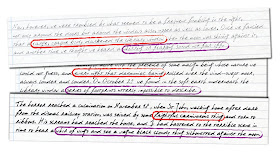Armed with these I started playing around with manipulating the shapes of the letters. I did this in two main ways — firstly by warping the glyphs using a wavy-shaped envelope. That gives a kind of overall impression that the writer is struggling to make the normal letter shapes due to a “disturbed” state. The other distortion I tried involved adding in lots of extra points around the glyphs and randomly jittering them around. This gives a “shaky” effect, like the writers hand is unsteady. The samples below show what these look like for light, medium and heavy versions of the font. Most of the text is distorted by the “wave” effect; the bits circled in red are treated with the “shaky” effect, and the sections circled in purple have both effects applied.
Tuesday, July 2, 2013
Mad Props
Insanity is a defining feature of encounters with the Mythos. Protagonists regularly spiral down into madness, slowly losing their grip on reality as they discover more of the horrific truth dwelling in the shadows. Dean Adelaide has a nice look at conveying that descent via increasingly erratic writing in notes and documents.

A little handwriting analysis goes a long way. Try these links for replicating prop handwriting of the disturbed, including handwriting of John Wayne Gacy and Jack the Ripper.
ReplyDeletehttp://www.toughcases.net/writingrhythm.html
http://www.handwriting.org/john-wayne-gacy.html
http://www.toughcases.net/ripper1.html
http://www.paralumun.com/graphology.htm
http://articles.chicagotribune.com/1999-07-31/news/9907310098_1_debra-spivey-barton-eloise-powell-spivey-leigh-ann-barton
http://www.leelofland.com/wordpress/sheila-lowe-can-handwriting-reveal-a-serial-killer/
http://www.annakoren.com/handwriting-analysis-of-serial-killers.html